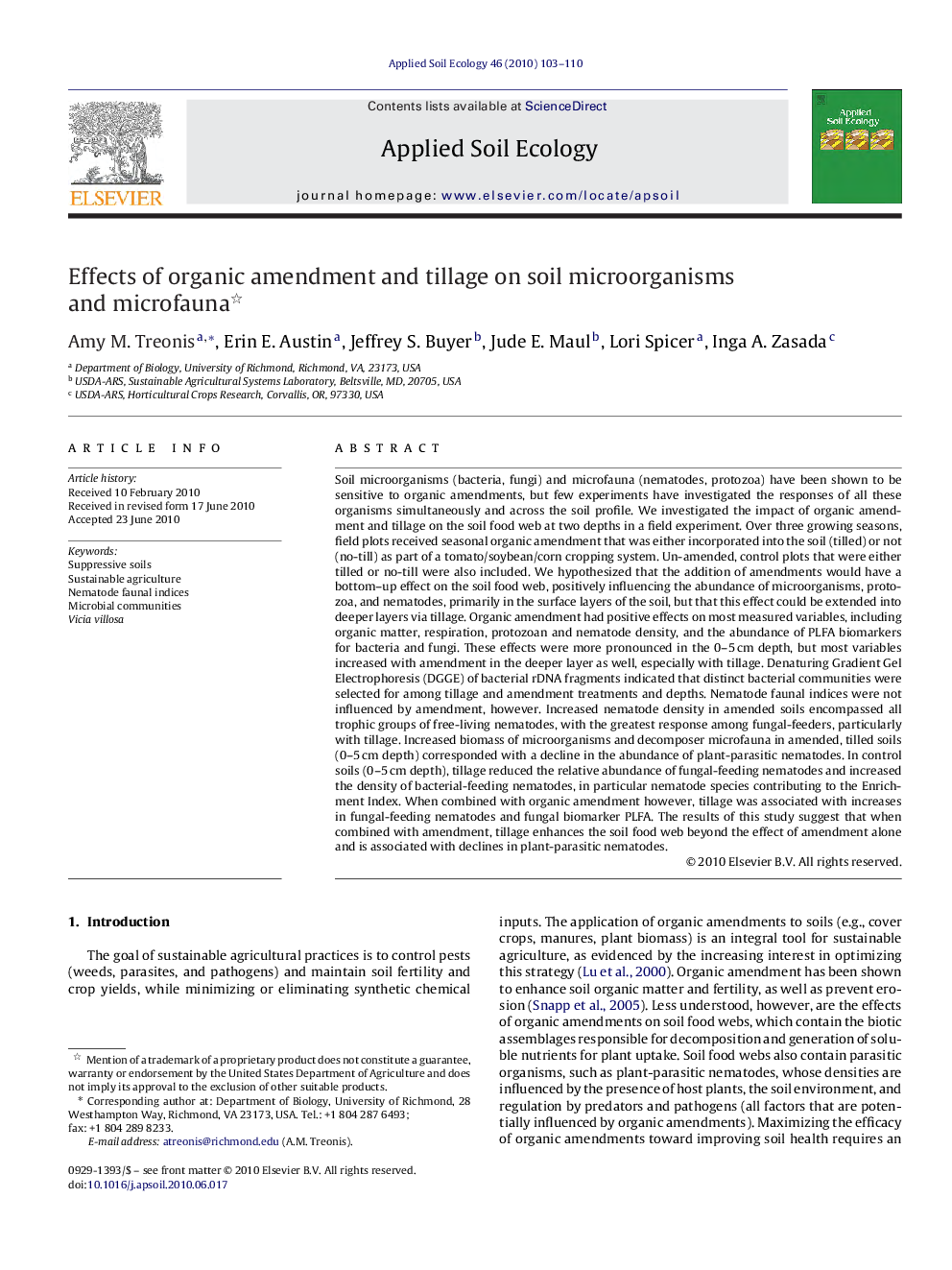| کد مقاله | کد نشریه | سال انتشار | مقاله انگلیسی | نسخه تمام متن |
|---|---|---|---|---|
| 4382774 | 1304230 | 2010 | 8 صفحه PDF | دانلود رایگان |
عنوان انگلیسی مقاله ISI
Effects of organic amendment and tillage on soil microorganisms and microfauna
دانلود مقاله + سفارش ترجمه
دانلود مقاله ISI انگلیسی
رایگان برای ایرانیان
کلمات کلیدی
موضوعات مرتبط
علوم زیستی و بیوفناوری
علوم کشاورزی و بیولوژیک
بوم شناسی، تکامل، رفتار و سامانه شناسی
پیش نمایش صفحه اول مقاله

چکیده انگلیسی
Soil microorganisms (bacteria, fungi) and microfauna (nematodes, protozoa) have been shown to be sensitive to organic amendments, but few experiments have investigated the responses of all these organisms simultaneously and across the soil profile. We investigated the impact of organic amendment and tillage on the soil food web at two depths in a field experiment. Over three growing seasons, field plots received seasonal organic amendment that was either incorporated into the soil (tilled) or not (no-till) as part of a tomato/soybean/corn cropping system. Un-amended, control plots that were either tilled or no-till were also included. We hypothesized that the addition of amendments would have a bottom-up effect on the soil food web, positively influencing the abundance of microorganisms, protozoa, and nematodes, primarily in the surface layers of the soil, but that this effect could be extended into deeper layers via tillage. Organic amendment had positive effects on most measured variables, including organic matter, respiration, protozoan and nematode density, and the abundance of PLFA biomarkers for bacteria and fungi. These effects were more pronounced in the 0-5Â cm depth, but most variables increased with amendment in the deeper layer as well, especially with tillage. Denaturing Gradient Gel Electrophoresis (DGGE) of bacterial rDNA fragments indicated that distinct bacterial communities were selected for among tillage and amendment treatments and depths. Nematode faunal indices were not influenced by amendment, however. Increased nematode density in amended soils encompassed all trophic groups of free-living nematodes, with the greatest response among fungal-feeders, particularly with tillage. Increased biomass of microorganisms and decomposer microfauna in amended, tilled soils (0-5Â cm depth) corresponded with a decline in the abundance of plant-parasitic nematodes. In control soils (0-5Â cm depth), tillage reduced the relative abundance of fungal-feeding nematodes and increased the density of bacterial-feeding nematodes, in particular nematode species contributing to the Enrichment Index. When combined with organic amendment however, tillage was associated with increases in fungal-feeding nematodes and fungal biomarker PLFA. The results of this study suggest that when combined with amendment, tillage enhances the soil food web beyond the effect of amendment alone and is associated with declines in plant-parasitic nematodes.
ناشر
Database: Elsevier - ScienceDirect (ساینس دایرکت)
Journal: Applied Soil Ecology - Volume 46, Issue 1, September 2010, Pages 103-110
Journal: Applied Soil Ecology - Volume 46, Issue 1, September 2010, Pages 103-110
نویسندگان
Amy M. Treonis, Erin E. Austin, Jeffrey S. Buyer, Jude E. Maul, Lori Spicer, Inga A. Zasada,